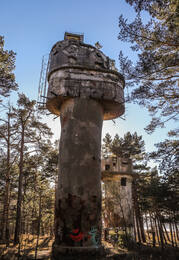Fake amber on the Liepāja side
For more than twenty years, the Liepāja coastline has been dangerous due to fake amber, which the sea tends to wash up from its depths especially generously during spring and autumn storms.
People who enjoy walking along the beach picking up larger and smaller grains of amber sometimes make a mistake and pick up a similar substance to amber washed up from the sea – white phosphorus. If you put it in your pocket and let it dry, it will ignite in the presence of air and leave severe and difficult-to-heal burns. Both young children and adults suffer from this. Both the people of Liepaja and the surrounding area, as well as tourists who have come to this side from Western Europe and the former USSR. There is no shortage of burns and burned body parts, just like there is for medics providing first aid. So where did this dangerous phosphorus come from in the Liepaja area?
During World War II, phosphorus was a common war material that was widely used in aviation incendiary bombs. It was with this type of incendiary bomb (and not only) that Allied aviation leveled Dresden to the ground during the February 1945 air raids. Eyewitnesses who survived said that even the street pavement had burned from the phosphorus incendiary bombs that were abundantly scattered over the city. A similar fate befell other German cities, including Leipzig. The Japanese capital, Tokyo, also experienced the destructive power of incendiary bombs when it was bombed by the US Air Force. Incendiary bombs were also used in air raids by both warring sides in Latvia during World War II, but there were no such massive air raids here. However, this was not the reason why the dangerous war material appeared on the seaside.
In 1988, during the USSR, the Baltic War District Command issued an order to destroy about 500 phosphorus aviation incendiary bombs that had survived since the Second World War. According to existing regulations, such charges must be dismantled and melted down, but they decided to do everything much simpler and faster – blow everything up. This was done at the Pape aviation target range, which was located between Jūrmalciems and Pape and occupied an area of 5,000 hectares. This area included both the dune zone and the sea. Studies show that as a result of this campaign, a huge area of 1,600 square kilometers could have been contaminated with phosphorus. No one can predict how long the sea will wash away this dangerous fake amber – perhaps even for the next hundred years, experts say. It is most often found on the beach between Bernāti and Liepāja. In the direction of Liepāja, the fake amber is washed away from Pape by the southerly current, which is said to be the dominant one here. The burns that people get from fake amber are severe and very deep. A Belgian citizen suffered burns to as much as 12% of his body. Tourists from Germany – a married couple – suffered first and second degree burns. A little boy brought amber home, hid it under a pillow, where the phosphorus ignited and almost burned down the entire house. And these are just a few cases, because no one has accurately counted the victims in 20 years, who perhaps went to collect amber, overcome by romantic feelings, but encountered the dangerous war agent – white phosphorus, which was left there by the USSR army.
Normunds Smaļinskis, 17.02.2010
www.delfi.lv, BNS, www.apollo.lv, www.industreality.lv, www.kurzemes-vards.lv
Related objects
Karosta, the Military port of Liepāja (tour)
The Karosta is the largest historical military territory in the Baltics and occupies almost one third of the entire territory of Liepāja. The Karosta is a unique compound of military and fortification buildings on the shores of the Baltic Sea with a special meaning in the history and architecture of Latvia and the world. The Karosta features such military heritage sites as the North Pier and forts, the Redan, Karosta Prison, Karosta Water Tower, St. Nicholas Orthodox Maritime Cathedral, Oskars Kalpaks Bridge and others.






